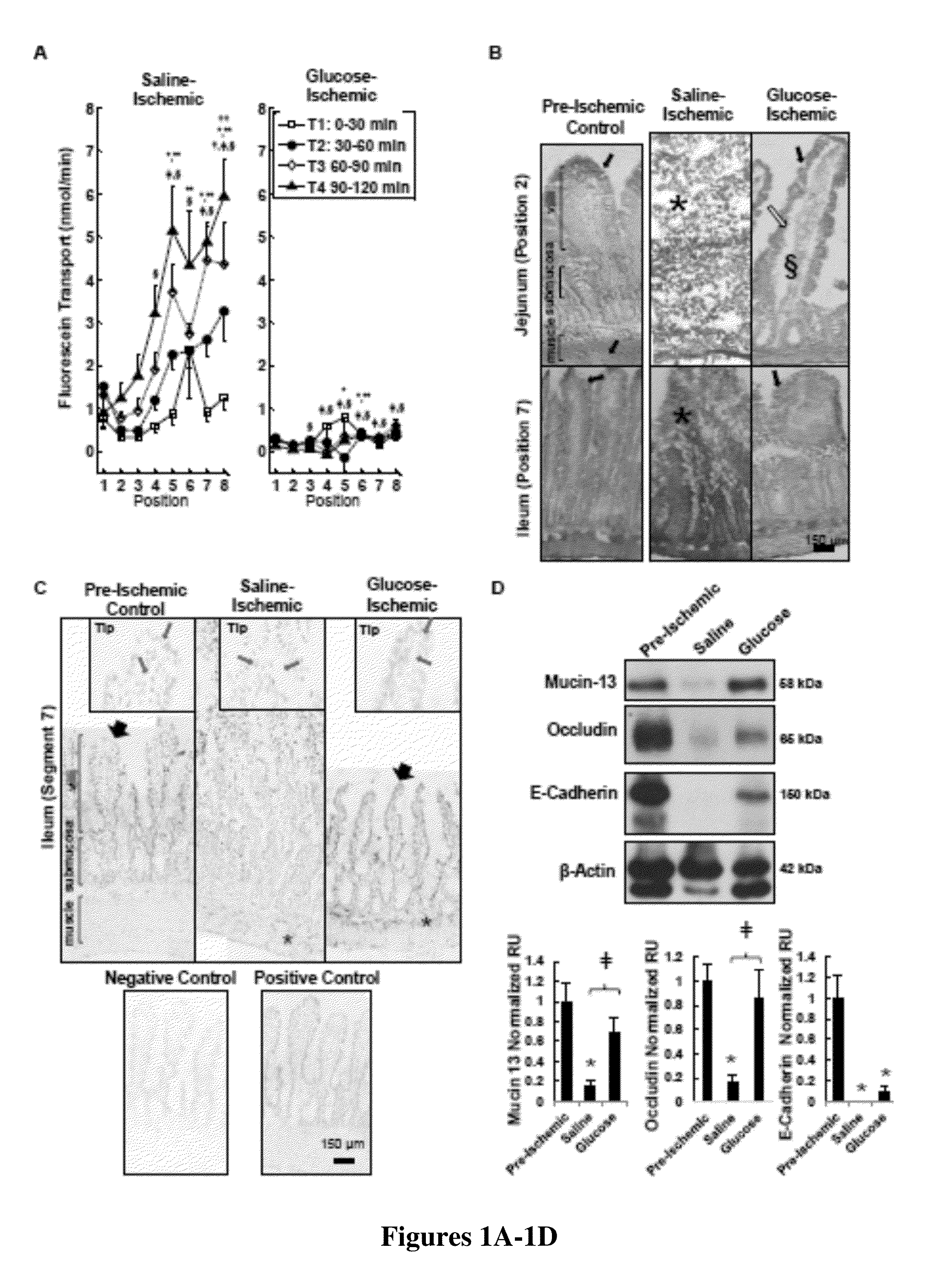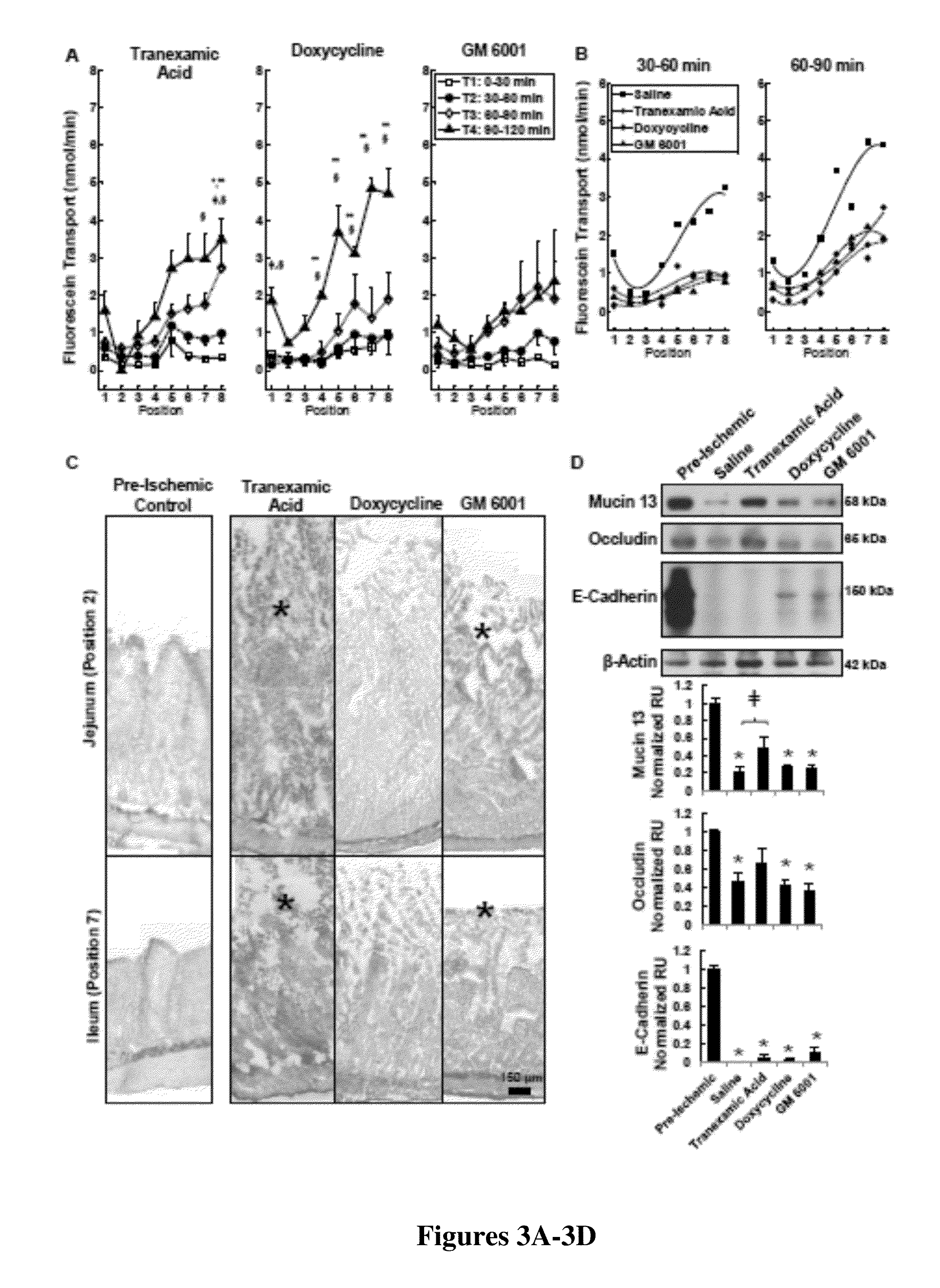Methods and compositions for preserving the mucosal barrier
a technology of mucosal barrier and glucose, which is applied in the field of preserving the mucosal barrier with glucose, can solve the problems of increased permeability and damage to the intestinal wall, and achieve the effects of increasing the transmural permeability of the intestine, increasing the transmural permeability, and reducing the risk of infection
- Summary
- Abstract
- Description
- Claims
- Application Information
AI Technical Summary
Benefits of technology
Problems solved by technology
Method used
Image
Examples
example 1
[0080]Male Wistar rats (body weight between 250-400 g, Harlan, Indianapolis, Ind.) for the intestinal ischemia model and male Sprague Dawley rats (body weight between 255-435 g, Harlan) for the hemorrhagic shock model were allowed food and water ad libitum prior to surgery. All rats were administered general anesthesia (xylazine, 4 mg / kg; ketamine 75 mg / kg IM.) and euthanized with B-Euthanasia (120 mg / kg).
[0081]Intestinal Ischemia—Since intestinal properties are non-homogenous, the transmural permeability was investigated over the entire length of the jejunum and ileum. Due to physical constraints of the small intestine anatomy, it is not feasible to simultaneously analyze permeability from multiple segments in vivo. Therefore, an ex vivo approach similar to previously published studies was designed to measure permeability along the length of the small intestine.
[0082]A midline incision was made to expose the intestine in anesthetized rats. The proximal end of the jejunum (approxima...
example 2
[0121]Adult male Sprague Dawley rats (mean±standard deviation (SD) body weight 340±60 g, N=64, Harlan, Indianapolis, Ind.) were allowed food and water ad libitum prior to surgery. Rats were administered general anesthesia (xylazine, 4 mg / kg; ketamine 75 mg / kg IM) and remained anesthetized throughout the experiment. At the termination of experiments, rats were euthanized by infusion of B-Euthanasia IV (120 mg / kg). The femoral artery and vein were cannulated. Systolic, diastolic, heart rate, and mean arterial pressure (MAP) were recorded throughout the procedure using LabChart (AD Instruments, Dunedin, New Zealand).
[0122]Hemorrhagic Shock (HS) with Removal of Luminal Contents—Animals were grouped into no-HS (No-HS), HS with intestinal luminal contents flushed (HS-F), and HS without intestinal flush (HS-NF). No-HS animals were immediately sacrificed for tissue collection following cannulation. All other animals were subject to laparotomy before the intestine was exposed and gross morph...
PUM
| Property | Measurement | Unit |
|---|---|---|
| body weight | aaaaa | aaaaa |
| body weight | aaaaa | aaaaa |
| inner diameter | aaaaa | aaaaa |
Abstract
Description
Claims
Application Information
 Login to View More
Login to View More - R&D
- Intellectual Property
- Life Sciences
- Materials
- Tech Scout
- Unparalleled Data Quality
- Higher Quality Content
- 60% Fewer Hallucinations
Browse by: Latest US Patents, China's latest patents, Technical Efficacy Thesaurus, Application Domain, Technology Topic, Popular Technical Reports.
© 2025 PatSnap. All rights reserved.Legal|Privacy policy|Modern Slavery Act Transparency Statement|Sitemap|About US| Contact US: help@patsnap.com



